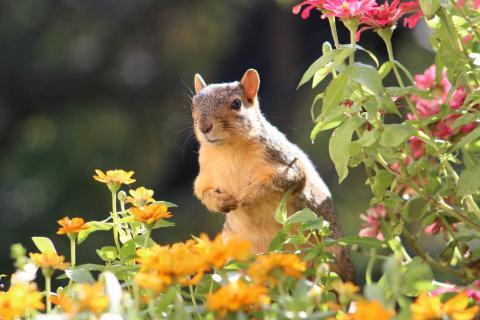
This summer, I planted tomatoes, strawberries, celery, Swiss chard, pole beans, and a variety of other vegetables and herbs on my deck. Last week, my harvest amounted to one small strawberry that had been obscured behind a leaf.
The reason?
Squirrels.
Squirrels aren’t the only animals that can wreak havoc in the vegetable garden. Other garden pests include deer, raccoons, rats, mice, groundhogs, voles, chipmunks, and birds. While it’s unlikely that you’ll be able to protect everything in your garden, there are ways to make it harder for critters to go for your prized heirlooms.
While it might be tempting to immediately call pest control, it’s worth thinking about the ecosystem at play. Some years are harder on animals than others, and while one year may be particularly devastating to the garden, next year might not play out the same. Likewise, don’t give up the garden all together. Here are several steps to take to reduce the amount of vegetables that are taken while supporting your local wildlife.
1. Fence
Fencing is often the easiest solution to keeping out unwanted visitors. Deer require high fences, up to 8 feet tall in some cases, while fruit tree fencing can be simply draped on fruit trees to prevent birds from picking the last of your cherries. Smaller, sturdier fencing—akin to chicken wire—might work well for rats and mice but taller fencing will likely be necessary to stop squirrels from crawling their way up and into the garden. Choosing the appropriate fencing will come down to the animals you’re hoping to keep out.
2. Protect Saplings
Young plants are often at risk of being turned into a salad by a hungry animal, so opt to protect these with extra fencing. Laying chicken wire directly on top of young saplings is an easy way to keep rabbits and rodents from nibbling on the tender greens.
3. Manage Your Yard
Rotting wood, poorly managed compost, brush piles, and general yard waste can be inviting for rats, mice, and other potential garden pests. Keeping your backyard well-maintained can go a long way toward keeping these animals out of your vegetable patch.
Spring is a great time to care for your yard after a winter of harsh winds and wet skies, but fall should also be used to prune branches, rake leaves, remove invasive species, and tend to any plants that are struggling.
4. Create More Habitat
On the other hand, creating habitat and food resources for animals that are natural predators for rodents and rabbits can also help. Try purchasing or building an owl box and hanging it on a nearby perch, and welcome predators into your yard by creating more animal habitat. Grasses, shrubs, bushes, trees, and rock features can create the shelter that prey animals need.
To keep animals’ diets full of native seeds, berries, and nuts, plant native trees and flowers. Depending on where you live, this might include sunflowers, coneflowers, honeysuckle, snowberry, milkweed, elderberry, and a variety of trees. Put out a bird feeder or even a squirrel feeder. The more appealing your yard and adjacent wildlands, the less necessary your garden.
5. Use Repellants
Odor repellants can be purchased from home and garden stores, though these aren’t the best option. For one, the repellants are designed to upset the stomachs of wildlife that consume them. Not all repellants work well, however, which means that even if you spray or coat your vegetable garden or the area surrounding it with a repellant, there’s no guarantee that wildlife will care. Additionally, repellants have to be reapplied often—likewise with homemade repellants like garlic or pepper sprays.
Longer lasting options include streamers and other objects that frighten animals due to their rapid movements caused by the wind. Letting your dogs have free run of the backyard can occasionally help, too, but be careful not to let your dog harm wildlife or vice versa.
6. Grow Animal-Repelling Plants
My front garden was destroyed until I planted a small row of marigolds. Suddenly my strawberries had protection while I enjoyed the cheerful sight of the marigolds’ yellow heads. Several vegetables, herbs, and flowers have pleasing tastes and aromas to humans while being offensive or off-putting to animals. Some varieties to try include lavender, garlic, rosemary, and other strong-smelling herbs.








